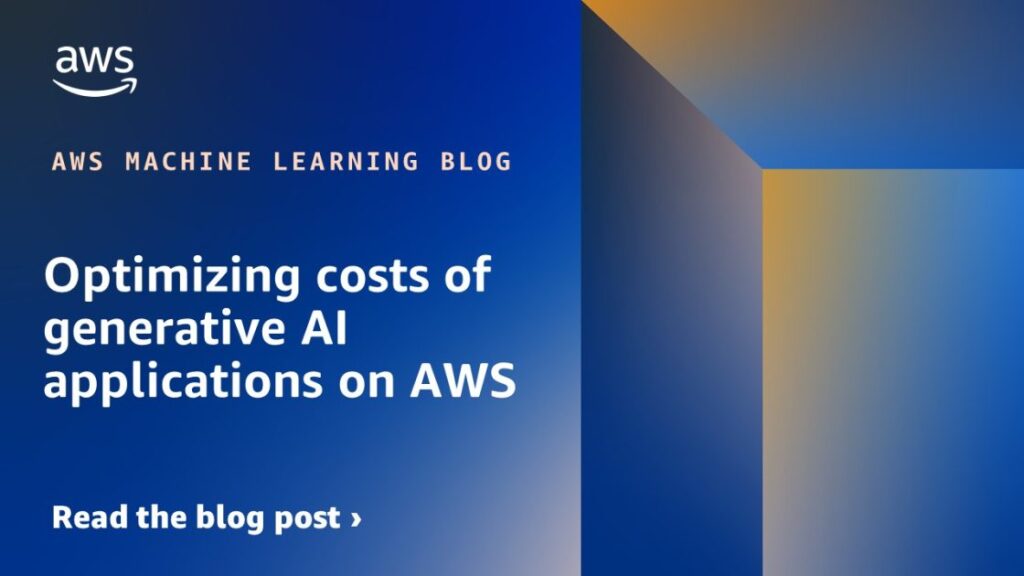The Economic Potential of Generative AI: Unlocking Value Through Cost Optimization
Generative AI is poised to revolutionize the global economy, potentially adding between $2.6 trillion to $4.4 trillion in value, according to a report by McKinsey & Company. The most significant contributions will come from enhancing customer operations, refining marketing and sales strategies, advancing software engineering, and boosting research and development efforts. As businesses nationwide rush to leverage generative AI on platforms like AWS (Amazon Web Services), understanding the costs and optimization strategies behind these technologies becomes crucial.
Cost Considerations for Generative AI in AWS
This article aims to shed light on vital cost considerations while enabling your organization to maximize the potential of generative AI on AWS. Before diving in, it’s essential to understand concepts such as foundation models (FMs), large language models (LLMs), tokens, vector embeddings, and the use of vector databases. A prominent framework in the generative AI field is Retrieval Augmented Generation (RAG), which this guide will address in the context of AWS’s Amazon Bedrock.
Key Optimization Pillars for Cost Efficiency
To harness the full capabilities of generative AI while managing costs effectively, consider the following optimization pillars:
-
Model Selection, Choice, and Customization
- Model Selection: Identify the most suitable model for your specific use cases and validate it against high-quality datasets.
- Model Choice: Different models come with varied pricing and performance. Choose wisely.
- Model Customization: Tailor foundation models using specific training data to heighten performance and cost-effectiveness.
-
Token Usage Monitoring
- Token Count: The cost of operating a generative AI model correlates directly with the number of tokens processed.
- Token Limits: Establish limits to control costs effectively.
- Token Caching: Utilizing caching for frequently asked questions significantly cuts costs and enhances performance.
-
Inference Pricing Plans
- On-Demand: Ideal for most applications with charges based on input/output tokens.
- Provisioned Throughput: Offers guaranteed throughput at a higher cost, suitable for heavy-demand scenarios.
- Additional Cost Factors
- Security: Integrating robust security measures can add to your overall costs but is vital for protecting sensitive data.
- Vector Database Costs: As usage grows, maintaining and storing data in a vector database incurs additional costs.
- Chunking Strategies: The way data is broken down and processed can heavily influence accuracy and expenditures.
Understanding Retrieval Augmented Generation (RAG)
Retrieval Augmented Generation empowers large language models to answer inquiries steeped in corporate data that the models were never explicitly trained on. For instance, an application using RAG first processes and chunks trusted company data, generates vector embeddings, and stores them in a vector database, essentially creating a knowledge base. The LLM then draws from this knowledge to respond meaningfully to user queries.
Forecasting Costs for Various Scenarios
When considering the creation of a virtual assistant for customer inquiries, annual costs can vary depending on demand. Here’s a directional snapshot based on the number of questions processed and the knowledge base size:
| Scenario | Monthly Questions | Annual Costs (Directional) | Unit Cost/1,000 Questions (Directional) |
|---|---|---|---|
| Small | 500,000 | $12,577 | $2.10 |
| Medium | 2,000,000 | $42,495 | $1.80 |
| Large | 5,000,000 | $85,746 | $1.40 |
| Extra Large | 7,020,000 | $134,252 | $1.60 |
*Note: The costs are estimated based on specified assumptions.
Strategies for Cost Management
As we dive deeper into cost-management strategies within AWS, consider the following:
1. Amazon Bedrock Pricing Plans
- Start with the On-Demand model for testing; this option typically involves lower costs. Transition to Provisioned Throughput only when necessary, preferably with a 1- or 6-month commitment during the initial phases.
2. Input and Output Tokens Management
- Since output tokens typically carry a higher cost, it’s wise to limit their usage by setting a maximum response size in your system prompts. Consider adjustable prompts for different groups with varying needs.
3. Vector Embedding and Database Costs
- Generating text embeddings incurs costs proportional to input tokens; managing data volume can help maintain expenditures. For instance, utilizing Reserved Instances can reduce costs long-term.
Conclusion
As organizations integrate generative AI into their operations, a keen focus on cost management will ensure they benefit from its full potential without unnecessary financial strain. The conversation surrounding costs and benefits is just beginning.
Be sure to keep an eye out for our upcoming article, which will discuss how to best estimate the business value derived from these advanced technologies.
The AI Buzz Hub team is excited to see where these breakthroughs take us. Want to stay in the loop on all things AI? Subscribe to our newsletter or share this article with your fellow enthusiasts.




